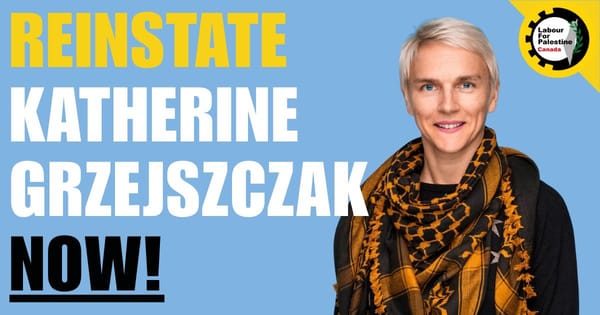
Are we in the midst of a union organizing surge? The Amazon Labor Union’s (ALU) recent victory at the JFK8 facility in Staten Island and the ongoing nationwide Starbucks Workers United (SWU) campaign portend positive signs. Unionization may even be spreading to the Apple Store.
Thus far, these union organizing campaigns have largely been confined to the United States — with Canadian union efforts at Amazon and Starbucks unfortunately proving unsuccessful. In fact, there may be something to the notion that things have gotten so bad for unions in the U.S. that space has been opened to try out new tactics and strategies.
Yet, as I’ve argued in a previous newsletter, American labour is barely treading water when it comes to union density and strike activity after decades of atrophy and decline. There does, however, appear to be something qualitatively significant about recent breakthroughs at Amazon and Starbucks. Young workers outside of the established labour movement are leading campaigns at staunchly anti-union employers and in hard-to-organize sectors of the economy — and in SWU’s case, in Republican states. Independent worker organizing — with few connections to long-established and much better resourced unions — is leading the way.
What explains this and what lessons might the labour movement draw from it? There are three basic points with which labour and the left must grapple. First, the Amazon and Starbucks campaigns underline — if labour needed a reminder — that there’s no substitute for rank-and-file worker participation, especially at avowedly anti-union employers. Second, the labour movement likely needs to rethink its ongoing relationship to independent unions and workers’ organizations. Last, while worker independence has proven advantageous during organizing, it’s far less certain how it will fare in collective bargaining where expertise and resources may prove necessary to secure a first contract and make gains going forward.
The Amazon Labor Union in New York is entirely independent from the established North American labour movement, while Starbucks Workers United, though backed by Workers United (a subsidiary union of SEIU), has nevertheless remained grassroots and worker-driven throughout its nationwide campaign.
The ALU is led by Christian Smalls, a former Amazon employee who was fired for leading a walkout over what he characterized as inadequate COVID-19 safety measures inside the facility, along with other current and former workers at the warehouse. Originally launched in Buffalo, N.Y., SWU has been on a tear of union certification victories across the U.S. At the time of writing, the union has notched victories at 25 Starbucks stores and publicly announced intentions to unionize at more than 200 other locations.
Both campaigns have relied on rank-and-file worker organizing and centred their grassroots independence from the established labour movement. As Jordan House and Paul Christopher Gray argue, the Staten Island Amazon campaign was successful in part because workers “formed an independent, grassroots organization to unionize their particular workplace.” Previous Amazon organizing campaigns of the RWDSU in Bessemer, Ala., and the Teamsters in Nisku, Alta., by contrast, were led by established unions with an insufficient leadership and base of support inside the warehouses.
The ALU, without outside labour support, engaged in a long-term organizing strategy that built trust among fellow workers. Organizers camped out at the bus stop servicing the facility, phone banked and frequently delivered food to employees inside the workplace, all to connect with prospective union members. High levels of support were generated over time through the union’s sustained ground game, which drew on the diversity of the workforce at a facility where immigrants comprise roughly half of employees.
Rank-and-file strength inside the workplace has also been especially important in countering the employer narrative that unions are “third party” organizations which disrupt the direct relationship between workers and management. When employees on site can demonstrate to undecided coworkers that they are in fact “the union,” this deceptive talking point appears far less plausible. For example, Amazon workers organizing within JFK8 were able to stand up to the employer and their hired union-avoidance “consultants” at so-called captive audience meetings where Amazon forced employees to sit through hours of anti-union propaganda. The ALU used Amazon’s heavy-handed union-busting tactics as an organizing tool to win fellow workers to their side. SWU has similarly used the plight of workers fired for organizing to boost its union campaign efforts.
The massive turnover rate at Amazon has long been thought to be an impediment to unionization. But here the ALU also defied long-held union assumptions. The U.S. National Labor Relations Board (NLRB) requires a union to show that at least 30 per cent of workers support the union by submitting signed cards before the Board will hold a supervised election. However, seasoned organizers advise obtaining a much higher level of support — perhaps 70 per cent — because unions inevitably lose workers when the employer kicks their union-busting campaign into high gear. Yet, the ALU — recognizing that the turnover rate would likely prevent them from ever reaching 70 per cent support on paper — chose to file for NLRB certification with only the bare minimum of union cards signed and instead focused on maintaining their ground game inside the workplace. In this way, union organizers ensured a majority of workers were on their side up to the official vote, regardless of workers’ employment tenure and whether they had originally signed cards.
These independent efforts need to be understood against the backdrop of the mainstream labour movement’s approach to new organizing campaigns. Established unions have often been reluctant to expend resources on what are commonly referred to as “hot shops” — workplaces where workers have independently organized to some degree, have significant grievances and are asking a union for organizing assistance. The thinking behind this is that fired up workers might be responding to immediate problems and may not have the fortitude to stick with an organizing drive through the process of officially certifying at a labour board and bargaining a first collective agreement.
Without naming names, I once heard a prominent Canadian labour leader defend this cautious organizing approach to an audience of students at York University, claiming it was a prudent use of union resources and member dues. While this line of argument didn’t satisfy a number of the students in attendance, it nevertheless made a certain level of sense, if regrettably. Unions do need to be responsible and (ostensibly) democratic with their members’ dues. There are certainly situations where union members would likely not support this money being used to support organizing campaigns with little chance of success. In other words, institutionalization tends to encourage caution and conservatism when it comes to organizing initiatives.
Yet, the ALU and SWU should encourage established unions and labour centrals to reevaluate their relationships with independent worker organizing campaigns. Clearly a lack of boldness from mainstream unions is translating into a situation where sizable numbers of workers are going at it alone and in some cases winning surprising and inspiring battles against huge employers with plenty of money to throw around. Perhaps “hot shops” are not such a high risk after all, at least not in the current political and economic climate where support for unions, particularly among young workers, is at historically high levels.
Finally, although independence has proven beneficial to the ALU and SWU in their organizing campaign thus far, these unions will face considerable challenges when they begin bargaining first contracts with Amazon and Starbucks. Both corporations are going to attempt to make an example of the unions, to try to demonstrate to workers at their other warehouses and stores that unionizing doesn’t deliver the goods. As part of this effort, both corporations will likely stall negotiations for as long as possible — a tactic that U.S. labour law doesn’t virtually nothing to prevent. According to research by the Economic Policy Institute, fewer than half of new bargaining units reach a first collective agreement within a year of certifying — and this is among established and much better resourced unions.
The ALU and SWU therefore face considerable obstacles in the months (and years) ahead. Rank-and-file organizing, engagement and participation will continue to be vital, but independence could also present its own challenges. The institutional capacity and resources of the established labour movement could be deployed to make sure these brave workers aren’t let out in the cold. In the long-term, both of these campaigns should encourage labour to be bolder and less cautious when it comes to new organizing campaigns. The future of the North American labour movement may well depend on it.







